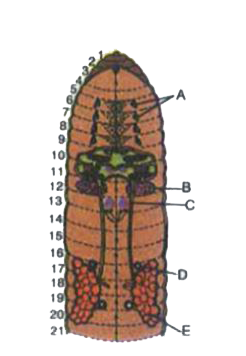X and Y are two human beings. The organ A in the reproductive system of X releases a mature gamete B once a month which goes into a tube-like structure C through a funnel-like opening. The organ D in the reproductive system of Y makes and releases gametes E which pass through a duct F and are introduced by an organ of Y, into the body of X. B and E fuse together in C to form a new cell G. The cell G divides repeatedly to form a ball of cells H which gets embedded in the lining of organ I of reproductive system of X where it grows and develops into a baby.
Out of X and Y, which one is (i) male, and (ii) female ?
To solve the question, we need to analyze the information provided step by step.
1. Identify Organ A: The organ A in the reproductive system of X releases a mature gamete B once a month. In humans, the organ that releases a mature gamete (egg) once a month is the ovary. Therefore, organ A is the ovary.
- Hint: Think about which organ in the female reproductive system is responsible for producing eggs.
2. Identify Gamete B: The mature gamete released by organ A is referred to as B. In females, the mature gamete is called an egg. Thus, gamete B is an egg.
- Hint: Recall the names of the gametes produced by males and females.
3. Identify Tube-like Structure C: The egg (gamete B) travels through a tube-like structure C. In females, the tube that carries the egg from the ovary to the uterus is called the oviduct or fallopian tube. Therefore, structure C is the oviduct.
- Hint: Consider the pathway an egg takes after being released from the ovary.
4. Identify Organ D: The organ D in the reproductive system of Y makes and releases gametes E. In males, the organ that produces sperm (the male gamete) is the testes. Therefore, organ D is the testes.
- Hint: Think about the male reproductive organs and which one produces sperm.
5. Identify Gamete E: The gamete E produced by organ D is sperm.
- Hint: Remember that males produce sperm as their gamete.
6. Identify Duct F: The sperm (gamete E) passes through duct F. In males, the duct that carries sperm from the testes to the urethra is called the vas deferens. Therefore, duct F is the vas deferens.
- Hint: Consider the pathway sperm takes to exit the male body.
7. Fusion of Gametes: The sperm (E) is introduced into the body of X (the female) where it fuses with the egg (B) in structure C (the oviduct). This fusion results in a new cell G, which is called a zygote.
- Hint: Think about what happens when a sperm fertilizes an egg.
8. Development of Cell G: The zygote (cell G) divides repeatedly to form a ball of cells H, which is referred to as an embryo.
- Hint: Recall the stages of development after fertilization.
9. Embedding in Organ I: The embryo (H) gets embedded in the lining of organ I of the reproductive system of X. In females, the organ where the embryo implants and grows is the uterus. Therefore, organ I is the uterus.
- Hint: Think about where a fertilized egg develops into a baby.
10. Conclusion: Based on the analysis:
- X is the female (as it has the ovary and produces the egg).
- Y is the male (as it has the testes and produces sperm).
Final Answer:
(i) X is female.
(ii) Y is male.
- X is the female (as it has the ovary and produces the egg).
- Y is the male (as it has the testes and produces sperm).
(i) X is female.
(ii) Y is male.
Topper's Solved these Questions
- HOW DO ORGANISM REPRODUCEBOOK - BETOPPERSCHAPTER - HOW DO ORGANISM REPRODUCEEXERCISE - COMPETITIVE WORKSHEET
44 Videos
- HOW DO ORGANISM REPRODUCEBOOK - BETOPPERSCHAPTER - HOW DO ORGANISM REPRODUCEEXERCISE - WORKSHEET 2
35 Videos
- HEREDITY & EVOLUTIONBOOK - BETOPPERSCHAPTER - HEREDITY & EVOLUTIONEXERCISE - COMPETITIVE WORKSHEET
34 Videos
- LIFE PROCESSESBOOK - BETOPPERSCHAPTER - LIFE PROCESSESEXERCISE - COMPETITIVE WORKSHEET
82 Videos
Similar Questions
Knowledge Check
Conglobate organ is a part of male reproductive system of
APrawnBCockroachCEarthwormDFrogConglobate organ is a part of male reproductive system of
APrawnBCockroachCEarthwormDFrogWhich is not the accessory duct in male reproductive system of human
AVas efferentBOviductCEpididymisDVas deferens
Organs of human male reproductive system which are not paired.
View SolutionOrgans of human male reproductive system which are not paired.
View SolutionWhere are gametes produced in the female reproductive system?
View SolutionIn the diagram of the reproductive system of earthworm A, B, C, D and E represent:

View SolutionThe reproductive organs in human females include
View Solution
